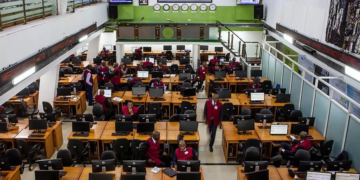Nigeria’s foreign exchange market recorded total inflows of $31.06 billion between January and July 2025, with foreign sources contributing 39.4 per cent of the total inflow, FMDQ Securities Exchange data has shown.
An analysis of the figures showed that foreign sources contributed $12.23 billion to total inflows during the period, accounting for about 39.4 per cent of the total.
Local sources supplied the remaining $18.83 billion, with exporters/importers bringing in $10.21 billion, making them the single highest contributor. The Central Bank of Nigeria (CBN) injected $3.15 billion into the market.
According to the FMDQ data, the highest overall monthly inflow was in May, when receipts surged 62.0 per cent month-on-month (m/m) to $5.96 billion from $3.67 billion in April, driven by a six-year high in local inflows and the strongest foreign inflows in three months.
The year started on a firm footing, with January’s inflows climbing 53.3 per cent m/m to $4.74 billion from $3.09 billion in December last year, supported by a 192.1 per cent surge in foreign inflows to $2.31 billion, the highest in nearly two years, as reforms such as the Electronic Foreign Exchange Market System (EFEMS) lifted transparency and investor confidence.
Stronger market confidence and attractive carry trade opportunities reflected in a 213 per cent increase in foreign portfolio investment (FPI), though inflows from other corporates and foreign direct investment (FDI) declined. Despite a drop from non-bank corporates, local inflows also rose by 5.6 per cent to $2.43 billion, supported by higher contributions from individuals, exporters/importers, and the Central Bank of Nigeria.
But February and March brought renewed weakness, with inflows down by 12.9 per cent and 5.5 per cent, respectively. This reflected global trade uncertainties and moderating yields that slowed FPI appetite.
Inflows declined to $4.12 billion in February, driven by a broad-based decline across foreign and local inflows.
Parsing through the breakdown, inflows from foreign sources declined by 10.5 per cent m/m to $2.07 billion, reflecting declines in inflows from FPI and FDI amid a surge in other corporate inflows.
At the same time, inflows from local sources dipped by 15.1 per cent to $2.06 billion due to declines in inflows from individuals, CBN, and exporters/importers amid an increase in inflows from non-bank corporates.
March’s inflow declined to $3.90 billion due to a substantial decrease in foreign inflow, which accounted for 20.2 per cent of total inflows. Foreign sources’ inflow dipped by 61.9% in March to $787.20 million, the lowest level in six months, due to erosion of market confidence amidst Trump’s tariff war.
In April, global trade tensions deepened as inflows dipped slightly by 5.7 per cent to $3.67 billion, driven by a 16.5 per cent decline in foreign inflows to $657.4 million, the lowest in seven months, due to weaker contributions from other corporates and foreign portfolio investments despite a sharp rise in FDI.
Local inflows, which comprised 82.1 per cent of the total, edged 2.9 per cent to $3.02 billion, as decreases from exporters/importers and non-bank corporates outweighed strong gains from individuals and the Central Bank of Nigeria (CBN).
Inflows into the market rebounded in May, jumping by 62 per cent month-on-month to $5.96 billion, driven by record-high local inflows, which were up 64.2 per cent to $4.96 billion, the highest in six years. Foreign inflows also rose by 51.7 per cent to $997.6 million, the strongest in three months, supported by improved market confidence. This was reflected in gains from foreign portfolio investments and other corporates, although FDI declined.
June’s numbers showed vulnerability, with total inflows falling 28.1 per cent from May’s peak, largely due to a 61.4 per cent plunge in local inflows to $2.11 billion, the lowest in four months. Meanwhile, foreign inflows jumped by 116.8 per cent to $2.73 billion, the highest in 29 months, fuelled by a 133.6 per cent rise in FPIs.
July, however, marked a renewed slowdown, with total inflows dropping by 20.9 per cent to $3.83 billion from $4.84 billion in June. The decline was driven by a 35.6 per cent fall in foreign inflows to $1.75 billion, reflecting steep drops in foreign direct investments (FDIs), other corporates, and foreign portfolio investments (FPIs).
Local inflows eased only by 1.9 per cent to $2.07 billion, buoyed by strong contributions from individuals (+117.5 per cent), the CBN (+77.8 per cent), and non-bank corporates (+5.4 per cent), which partially offset a 30.1 per cent drop in exporters/importers’ inflows.











